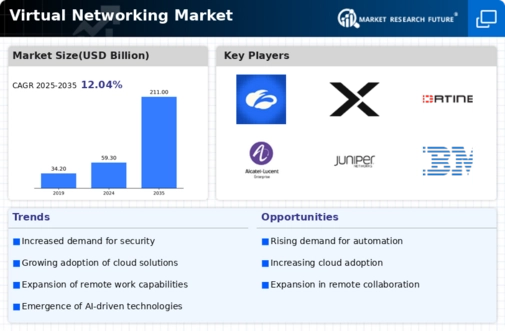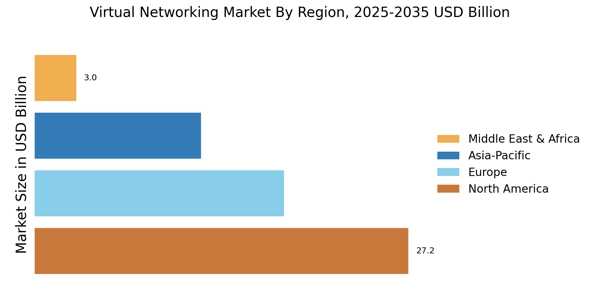Increased Focus on Cybersecurity
In the context of the Virtual Networking Market, the heightened focus on cybersecurity is a significant driver. Organizations are increasingly aware of the vulnerabilities associated with virtual networking, leading to a surge in demand for secure networking solutions. Recent statistics suggest that cyberattacks have risen by over 30% in the past year, prompting businesses to prioritize the protection of their digital assets. As a result, investments in advanced security protocols, such as encryption and multi-factor authentication, are becoming commonplace. This emphasis on cybersecurity not only safeguards sensitive information but also enhances trust among clients and stakeholders. The integration of security features into virtual networking solutions is thus becoming a key differentiator in the market, as companies seek to mitigate risks while leveraging the benefits of virtual connectivity.
Integration of Advanced Technologies
The integration of advanced technologies is a pivotal driver in the Virtual Networking Market. Innovations such as artificial intelligence, machine learning, and the Internet of Things are transforming how virtual networks operate. These technologies enhance network management, optimize performance, and improve user experiences. For instance, AI-driven analytics can predict network congestion and automatically adjust resources, leading to a more efficient use of bandwidth. Recent studies indicate that companies leveraging advanced technologies in their virtual networking solutions report a 30% reduction in operational costs. This trend suggests that as organizations seek to enhance their networking capabilities, the adoption of advanced technologies will play a crucial role in shaping the future of the Virtual Networking Market.
Demand for Enhanced Collaboration Tools
The demand for enhanced collaboration tools is significantly influencing the Virtual Networking Market. As teams become more dispersed, the need for effective collaboration solutions has intensified. Virtual networking platforms that integrate collaboration tools, such as video conferencing, file sharing, and real-time messaging, are increasingly sought after. Recent data shows that organizations utilizing comprehensive collaboration tools experience a 40% improvement in team productivity. This trend underscores the importance of seamless communication in achieving business objectives. Companies are investing in virtual networking solutions that not only provide connectivity but also foster collaboration among team members, regardless of their physical location. As the workplace continues to evolve, the demand for enhanced collaboration tools within the Virtual Networking Market is expected to grow.
Rising Demand for Remote Work Solutions
The Virtual Networking Market is experiencing a notable surge in demand for remote work solutions. As organizations increasingly adopt flexible work arrangements, the need for robust virtual networking tools has become paramount. According to recent data, the market for remote work technologies is projected to grow at a compound annual growth rate of 20% over the next five years. This growth is driven by the necessity for seamless communication and collaboration among distributed teams. Virtual networking solutions facilitate this by providing secure and efficient connections, enabling employees to access company resources from anywhere. Consequently, businesses are investing heavily in virtual networking infrastructure to enhance productivity and maintain operational continuity. This trend indicates a shift in workplace dynamics, where virtual networking is not merely an option but a critical component of modern business strategy.
Growing Need for Scalability and Flexibility
The Virtual Networking Market is witnessing a growing need for scalability and flexibility in networking solutions. As businesses expand and evolve, their networking requirements become increasingly complex. Organizations are seeking virtual networking solutions that can easily scale to accommodate fluctuating demands without compromising performance. Recent market analysis indicates that companies that adopt scalable networking solutions experience a 25% increase in operational efficiency. This trend is particularly evident in sectors such as e-commerce and technology, where rapid growth necessitates adaptable networking infrastructure. Virtual networking solutions that offer flexibility allow businesses to respond swiftly to market changes, ensuring they remain competitive. Consequently, the demand for scalable and flexible virtual networking solutions is likely to continue rising, shaping the future landscape of the industry.


















Leave a Comment